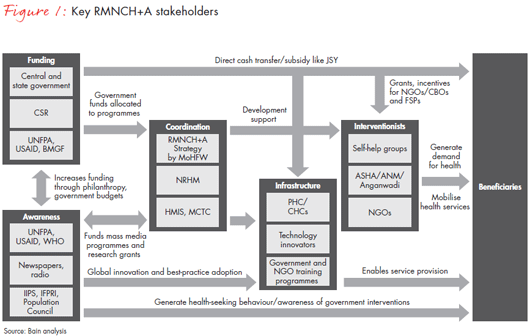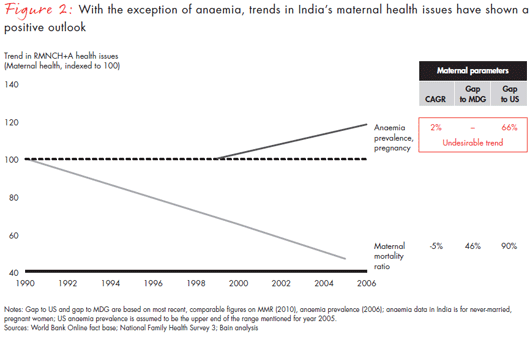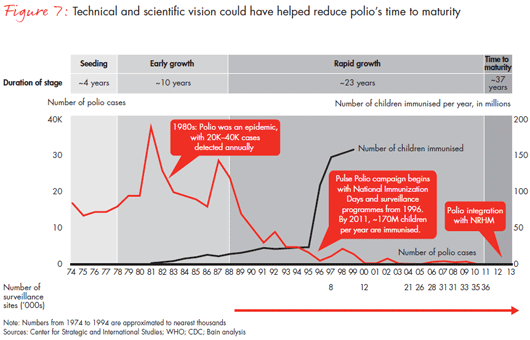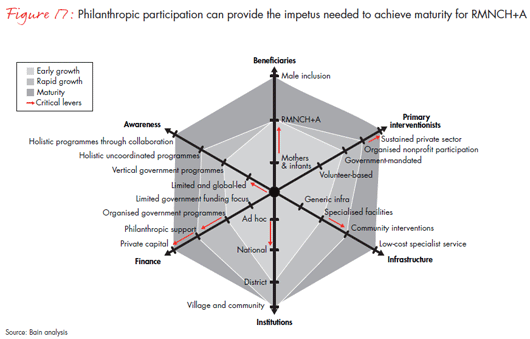贝恩:印度慈善事业2014年报告(英文 32 页)
RELATED ARTICLES
Growing business opportunities for healthy living India Philanthropy Report 2013INDUSTRY EXPERTISE
Social and Public Sector Healthcare- An ecosystem of stakeholders is needed to tackle society-wide problems like poor access to essential healthcare for women and children. Achieving large-scale goals without such a setup would be slow and suboptimal.
- India has a successful track record in addressing society-wide issues on a large scale. Developing comprehensive ecosystems for polio, HIV and microfinance was critical to India’s successes in those areas.
- Studying those successes led us to conclude that there are six critical actors in the ecosystem: beneficiaries, interventionists, coordination bodies, infrastructure providers, funders and organisations that promote awareness.
- A reasonable base for RMNCH+A has been established, with strong government and emerging nonprofit participation, despite long periods of stasis since India’s independence.
- The RMNCH+A ecosystem will need to address issues across health, nutrition, education and sanitation.
- There has been significant improvement in women and children’s health over the last 15 to 20 years: Maternal and infant mortality rates, the number of underweight children and child marriages and the total fertility rate have all declined. However, several areas of concern remain; for example, a high rate of anaemia among mothers and children.
- The successes of other ecosystems also suggest that non-state actors and funding can be game changers. But this can’t occur in a vacuum and will need strong coordination bodies, infrastructure and innovation.
- India’s economic growth is expected to be strong: about 5% in real terms, on average, until 2035.
- On the back of this growing economy and through government interventions like the National Health Mission (NHM), the share of GDP spent on public health is expected to increase from 1% currently to 1 .7% in 2035, generating additional public funds to meet the agenda for RMNCH+A.
- However, public funds alone will be insufficient; other participants will have to step in. By 2025, India will need an incremental $12 billion over the public health expenditure. With economic growth and rising spending, that amount will be reduced to an incremental spending of about $3 billion in 2035.
- To achieve the 2035 outcomes, it will be necessary to address the funding gap through non-state sources of funding and by building an ecosystem to effectively deploy the funds.
- Non-state funding will have to be generated by private sources; multilaterals and bilaterals are unlikely to increase their current giving of about $0.7 billion.
- Doubling the current share of contributions to health through corporate social responsibility (CSR) and high-net-worth individuals (HNWIs) in India can provide an additional $2.7 billion by 2025.
- This will leave a gap of approximately $8.6 billion by 2025, which will have to be funded through private foreign donations to achieve the 2035 objectives.
- Non-state participants focused on strengthening health systems and scaling up programmatic interventions can also act as catalysts in the development of a vibrant ecosystem. They can also help expand the deliver y system facilities, quality of care, technologies and awareness.
- Support networks will need to help channel funds from private and philanthropic sources to grass-root organisations. And to grow, these organisations will need regulatory and legal support.
- Incrementally, government agencies like the NHM must meet their mandates, and vertical programmes must find a way to work with one another.
- New innovations will also be needed to drive disruption via low-cost technologies, multisector partnership models and direct community outreach.
- Beneficiaries:recipients of the services
- Interventionists:skilled and semi-skilled workers who execute the needed services in the field
- Infrastructure providers:physical establishments, technology and training to enable the services
- Funders:sources of capital that support the activities of various stakeholders
- Coordination bodies:strategic monitoring and decision-making entities for systemic progress
- Organisations that promote awareness:development agencies, mass media and research institutions








- Seeding:an early stage of evolution, characterised by ad hoc actions to address a perceived issue and understand its scope
- Early growth:characterised by the emergence of a coordinating body and by a better understanding and estimate of the full crisis
- Rapid growth:marked by the emergence of non-government participants (donors, philanthropic and private organisations), whose activities both complement and surpass those of organised government or quasi-government participants
- Maturity:reached when the ecosystem’s growth rate stabilises, with players developing their own distinct roles and functions






- Disaster:Negligible GDP growth and limited incremental healthcare investment would worsen the situation. RMNCH+A outcomes would stay at the 2011 level in this scenario. We believe this is an extremely unlikely scenario, however, based on several public estimates.
- “Ceteris paribus”:India continues to chug along at 5% real GDP growth, with no disruptive changes in the ecosystem and rate of investments. This would lead to improvement in the outcomes at the historical rate, reaching targets in 2055.
- Disruptive opportunity:GDP growth of 5%, coupled with an enhanced rate of investment and changes in the ecosystem, can drive transformational outcomes. Targets may be reached by 2035, the optimal scenario.


- As of 2011, the share of RMNCH+A spending as a percentage of GDP is 0.8%, which is 70% of India’s total public health expenditure. This $13 billion comes through four funding programmes relevant to the RMNCH+A agenda: the central NRHM (recently integrated into NHM), NACO, state budgets and local bodies.
- At the current pace, with a real GDP growth assumption of 5% (based on OECD estimates) until 2035, the government expenditure for RMNCH+A is estimated to be $25.6 billion in 2025 and $42 billion in 2035.
- Organisations like the World Health Organization expect that total public health spending will increase from current levels of 1% of GDP to 1.5% by 2025 and 1.7% by 2035 in India.
- With a constant share of RMNCH+A spending at 67% of total health spending, this will translate into an additional RMNCH+A spending of $12 billion by 2025 and $27 billion by 2035 (see Figure 9).


















[报告关键词]:
慈善
×
![]()
所属专题:
贝恩咨询
下载《贝恩:印度慈善事业2014年报告(英文 32 页)》需 20点,包月包季包年会员(点此注册)免费下载。
一、非注册用户快速自助下载两步完成:1 注册(点此),2 购点卡(点此) 充值(点此)自主下载
二、非注册用户直接付款( 点此付款),付款后短信(18121118831或加微信)告知 题目或者Email,我们通过邮件发给您。 需要帮助?
一、非注册用户快速自助下载两步完成:1 注册(点此),2 购点卡(点此) 充值(点此)自主下载
二、非注册用户直接付款( 点此付款),付款后短信(18121118831或加微信)告知 题目或者Email,我们通过邮件发给您。 需要帮助?
专题跟踪研究报告
企业出海
新质生产力
低空经济
生成式AI
工业互联网
数字藏品
动力电池
ESG
数字化转型
机械零部件
氢能
碳中和
区块链
元宇宙
建筑
矿产
安永
数字货币
新基建
日化
案例分析
毕马威
贝恩咨询
普华永道
波士顿
罗兰贝格
德勤咨询
埃森哲
麦肯锡
电商
金融科技
人工智能
物联网
互联网金融
大数据
3D打印
食品饮料
家电行业
零售连锁
新能源
商业地产
快递行业
机械设备
汽车
核电
电子产业
电力行业
新兴产业
纺织服装
医药生物
广告传媒
金融投资
航空
旅游
酒业
能源
有色金属
通信
石油化工
物流供应链
房地产
可行性报告
PPP
商业计划书
五力分析
并购重组
发展战略
SWOT
产业链
钻石模型
价值链
PEST
人力资源
面板模型
stata
精华推荐
供应链金融
互联网+
机器人
O2O
教育培训
论文资料查找
写作修改服务
EMBA论文写作
硕士论文
本科论文
论文写作

